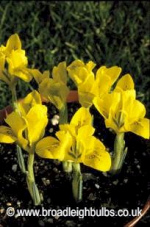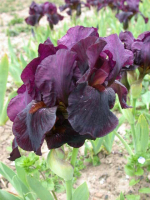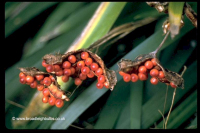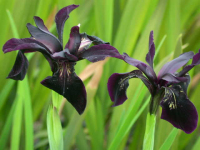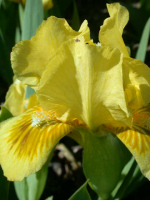This article is split into Iris for Mixed Border, Water side, Semi-shade and the Rock Garden. There are cultivation notes at the end.
Introduction
Whether its a haze of flag iris shimmering in the heat of Monet’s garden or rimming his waterlily pool, a bowl of stylosa on a winter windowsill or a bunch of Dutch Iris in a florist’s bucket the word iris conjures a host of different images. Not only do they flower for more than 6 months, from Nov-June, each has very different cultural requirements. Appropriately named after the Greek goddess of the rainbow, they are found wild throughout the Northern Hemisphere and have long been cultivated for their colourful flowers. In Turkey one has always been used to decorate grave yards whilst in Italy another is an important ingredient in the perfume industry. I have seen them massed in high Himalayan bogs, clinging to life on an arid Greek hillside and lining the banks of our local canal. With such a disparate distribution there is sure to be an iris suitable for virtually every part of the garden.
Mixed border
The first iris that usually springs to mind is the flag or bearded iris. These have a broad, fleshy rhizome on the surface of the soil and a fan of grey-green leaves. They have a long history of cultivation and even in the 17th century many hundreds of hybrids were recorded. Some of the best known are still cultivated today such as the rich purple Iris germanica, Iris g. Florentina (orris root) and the variegated form of the scented Iris pallida. Although they all have relatively small flowers they are very tolerant garden plants for any well drained soil in full sun.
The large and often dramatically coloured modern bearded iris has a complex genetic history. They are architectural in form, carrying their large, flamboyant flowers on upright stems. For ease they have been classified according to height, from tall (70cm) to miniature dwarf (-20cm). Curiously their flower size does not vary so dramatically, most being 3-6″ across. They are easily grown in a limey soil in full sun and their colours, covering a huge spectrum, often contrasted or subtly mixed, means that there is always one to match any colour scheme. I must admit that I choose them by colour and not name, there are so many available. Although traditionally grown by themselves I prefer them as part of a mixed planting and use them to back our herb garden. Care must be taken to ensure that the rhizomes are in the sun and not shaded by surrounding plants. In a wide border the intermediate varieties, such as the almost red-black Iris ‘Langport Wren’, are perfect for the middle with some of the dwarf bearded iris along the very edge.
One of the easiest, for a soil that is not too dry, is Iris sibirica and its hybrids. They produce dense clumps of slender leaves topped in May or June by a mass of dainty flowers. These may be blue, violet, white or attractively veined. Their early flowering and neat habit even when out of flower, makes them ideal for the mixed border. The lovely creamy-yellow and white ‘Butter and Sugar’ is one of my favourites as is the free flowering ‘White Swirl’ The robust, 1m tall Iris orientalis with its slender yellow and white flowers is ideal for a dry, sunny border. Although by no means a showy plant every garden should have a clump of the dwarf Iris graminea tucked into a corner. The slender, deep purple flowers are almost hidden by the narrow leaves but they really do smell of hot plum tart and are produced in such profusion that there are plenty to cut.
I have not mentioned the Xiphium ( Dutch, English and Spanish) iris as personally I think these rather stiff florist iris can be difficult to integrate into a border. Tight clumps of a single colour are the most effective way of planting them, although that may take some effort to achieve as the bulbs are usually sold in mixed colours only. One of the most effective associations I saw occurred by chance. A solitary golden Dutch iris was almost obscured by a cloud of violet aquilegia flowers that had seeded on top of it leaving it rather like an exotic butterfly and beautifully disguising its inherent stiffness..
Water side
Iris are one of the easiest and most attractive of the marginal plants. Only Iris laevigata itself must be grown actually in water all the time, Although they make attractive pond side plants, Iris ensata and Iris versicolor will also grow quite happily in any moist, rich soil that does not dry out and preferably does not contain excessive lime. There are many named forms and they come in all shades and mixes of blue, purple and white, including double flowered varieties. Some of the most dramatic are the modern Japanese hybrids which have unbelievably complicated marking, There is a fine collection of them in the wild garden at at Wisley, a gift from a Japanese student. I find them very vigorous and easy to propagate by division early in the spring, although August is the more traditional division time for these and most other iris.
The familiar yellow flag iris of the water meadows. Iris pseudacorus, is much too vigorous for most gardens. However the almost glowing golden leaves of Iris p.’Variegata’ are particularly beautiful in early spring. It can be grown in an ordinary border, provided the soil is not too dry, and where it will be of a more manageable proportion than if it was alongside a pool. I prefer the delicate lemon flowered form which I grow beside my large pond where it is mixed with Zebra grass and a golden rush. There are some fine new forms with dramatically marked flowers – ‘Roy Davidson’ and ‘Tiger Brother’. But no matter which form is grown do not let them seed or they will quickly become a nuisance. I must admit that I also find the blue Iris versicolor a little too generous with its offspring.
All forms of Iris sibirica love the moist soil beside a pond. They flower earlier than the traditional water iris and are useful to extend the season as well as adding yellow to the usual blue/white colour range. The shorter Iris setosa also thrives in the dampness of a pond margin, producing its light blue or violet flowers in early summer. I ‘Gerald Darby’ is much more robust, producing a succession of strongly veined purple flowers on well branched, almost black stems. The most dramatic of the water loving iris are the Japanese I. ensata hybrids with their amazing flat flowers, often streaked and marbled.
Dry, sunny borders
One of the joys of winter is the perpetual succession of blooms on my various forms of Iris unguicularis – still better known under the old name of Iris stylosa. Whenever the temperature rises above freezing for a few days they will produce flowers, many hundreds over the season on established clumps. All are native of the poor soils and dry conditions of the S. Mediterranean and N. Africa and flower best when tucked in against a south facing wall. There are many forms available but I still think Iris ‘Mary Barnard’ is one of the best. It is certainly the most floriferous. It has slightly narrower leaves than the type and starts producing its rich purple flowers early in November and, in cool springs, has been known to continue well into April, although March is more normal. One common complaint is that established clumps tend to be rather untidy in appearance. This can be partially overcome by reducing the leaves to 2/3 their length in late autumn and by gently raking out the dead foliage. This has the additional benefit of also reducing the resident snail population that frequently causes unsightly holes in the flowers.
A warm, sheltered wall is also the perfect home for the slightly tender I.japonica.These have a broad fan of leaves and exotic pale blue or white frilly flowers, dramatically splashed with purple and with an orange crest. ‘Ledger’s Variety’ is reputedly the hardiest form. There is also a variegated form with attractively striped green and white leaves. Iris tectorum is another crested Chinese iris for similar conditions.
Semi shade
Although iris are principally associated with full sun there are some species that not only tolerate but actually thrive in cooler conditions. Iris foetidissima, called the roast beef iris after the smell of its crushed leaves, is one of the most adaptable plants regarding soil or position. It is is naturalised here in Somerset, often appearing in hedgerows, and can be somewhat invasive. The plant that I enjoy most has seeded itself into a mat of variagated vinca carpeting the base of a huge yew tree. I never notice its slender leaves and certainly overlook the insignificant brownish flowers that appear in April. Then in September the fat seed capsules open to reveal glowing, sealing wax red seeds that remain on the plant well into the new year, a perfect foil for the pale vinca. There is a variegated form, valued as a foliage plant in its own right although it tends to be prone to rust if not divided regularly.
For many years Broadleigh Gardens has been virtually synonymous with the evergreen Pacific Coast iris. Often called “orchid” iris when we show them at the Chelsea Flower show, they are the result of crossing various Californian species. The resultant progeny have one of the widest ranges of colours of all the iris, usually with a contrasting, veined mark on the falls. All require a neutral to acid soil and are particularly effective used, as I first saw them, lining a path through a rhododendron wood. Their subdued colours are complimentary to those of the rhodos. Unlike most iris they flower just as well in partial shade as full sun. The early flowering and rather upright yellow and white ‘Agnes James’ and the clear blue ‘Broadleigh Carolyn’ would be among my first choices. Like most of the non-bearded iris the clump gradually expands outwards from the center and should be divided at regular intervals, discarding the central portion. We do this in late August.
Not all iris are showy giants, some of the real gems of the genus are very small indeed. The tiny 6cm tall Iris cristata and the closely related Iris lacustris also prefer a humus rich soil in partial shade. Considering the size of the tiny rhizome, connected to each other by thread-like stolons, their rather flat, blue or white, crested flowers are remarkably large. They gradually spread outwards to form quite extensive patches and are are best divided just after flowering.
Although Iris lazica is an Iris unguicularis relative it comes from the cooler Black Sea coast and prefers a semi-shaded position, as we dicovered to our cost having struggled for some years to grow it in full sun with our main Iris unguicularis collection. It is now much happier in a shaded bed under a north wall where it freely produces its narrow, heavily veined purple-blue flowers.
I shall never forget seeing the striking Iris chrysographes high in the mountains of Yunnan. Although related to Iris sibirica I grow it as an understorey in a mixed shrub border where there is plenty of moisture available. It is a highly variable plant and it is well worth hunting for the best forms which have rich, velvety, almost black flowers.
Rock Garden
As winter eases its grip on the garden so the first of the bulbous iris appear. These are members of the reticulata group. All produce narrow, triangular leaves and a single, slender bloom, principally in shades of blue and purple, often with an attractively contrasting orange or yellow mark at the top of the fall. They are best planted in small clumps and are ideal for a sunny rock garden where they associate well with other early spring flowering bulbs such as crocus. I like to grow them through low growing grey foliage plants. Reticulata iris are naturally snow melt plants of the high mountains in the Middle East, conditions that are not easily replicated here. One of the principal problems is that after flowering the bulb splits into many tiny bulbs that can take up to 7 years to reach flowering size again.
Deep planting (20cm) will discourage splitting however I’m afraid I take the lazy way out and plant a few new clumps each year. ‘Harmony’ and ‘Edward’ are two of my favourites. Sadly the very vigorous Iris histrioides ‘Major’ is no longer available although its rich purple form ‘George’ is proving to be a good substitute. Alternatively you could try the unusual Iris ‘Katharine Hodgkin’. Its exotic colouring of cream overlaid with a blend of light yellow and greeny-blue comes from its parents, Iris histioides and Iris winogradowii, the latter having also imparted its higher tolerance of our climate making it a reliable, free flowering perennial provided you keep the slugs at bay.
The dwarf bearded iris also make their home on the sunny rock garden where their samm stature is perfect for the other low growing plants. They range in height from 4″ to 10″ and come in a kaleidoscope of colours, from simple single colours to amazing combinataions.
Although not strictly speaking an iris, Hermodactylus tuberosus, the Snake’s Head or Widow Iris, with its finger-like tubers and velvety brown flowers is very closely related to Iris reticulata. It will grow rapidly in a light well drained soil but will only flower well if given a dry summer dormancy. Here it has become naturalised in grass under a large oak which keeps it dry in summer.
My rock bank is also home to two very dissimilar species. One of the most unusual iris, both in and out of growth is Iris bucharica. It is the only member of the beautiful Juno iris group that can be grown with ease in the open garden. Its strange, greenish yellow flowers rise out of an interlocking fan of shiny apple-green leaves and come from a rootstock that is half bulb and half tuberous root. It flowers in mid spring. Flowering later in the summer is a dwarf, evergreen iris from the Balkans and Turkey. Iris sintenesii is easily grown and deserves to be more widely grown. At first glance the flowers appear to be a deep violet-blue but a closer inspection reveals them to be a heavily veined white, which gives them an almost metallic sheen.
The dwarf bearded iris also find their home among other low growing plants on the rock garden.. The strange Iris ‘Forest Light’ has long inhabited my rock garden where its greeny-yellow flowers associate well with the grey blue of Ipheion uniflorum. Another good combination is ‘Little Sapphire’ with Tulipa batalinii ‘Apricot Jewel’. Once again there are many hundreds of varieties and colour combinations to choose from.
Cultivation/ propagation
1. With the exception of the bulbous iris all should be planted with the rhizome at or just below the soil surface.
2. Late summer is the best time to move or divide most iris.
3. When dividing iris reduce the rhizome to a young, vigorous piece, discarding the old rhizome.
4. Water all iris in dry weather the first season after transplanting to help them establish a new root system.
5. Plant bulbous iris 4-8″ deep in autumn. Juno iris should only be planted 2″ deep. Lift and divide bulbous iris as the leaves fade.
6. Most species iris can be grown from seed although some may take many years to flower. Hybrid iris will not come true to name.
7. Feed with a low nitrogen, slow release fertilizer.
8. With the exception of water edge varieties iris prefer a well drained soil. Add grit and humus to heavy clay soils. Lime may be beneficial for very acid soils.
9. Avoid covering the rhizome with mulch, especially FYM
We sell different iris at different season:
Spring (January) catalogue- plants posted Feb-April
Dwarf bearded, species iris such as chrysographes, ensata, sibirica and winter iris ( I unguicularis or stylosa)
Autumn (June) catalogue – bulbs posted Sept-Nov
Pacific coast, reticulata and other bulbous iris
See Online Store for current availability

